A Review of Red Mars, the Most Important Novel on Terraforming

"And so I say, among all the many things we transform on Mars, ourselves and our social reality should be among them.
We must terraform not only Mars, but ourselves."
- Arkady Bogdanov, Red Mars
Writing exceptional science fiction stories is no easy feat. On the one hand, the author must try to push towards the main idea or theme they want their readers to take away from their book, while painting it craftily in an environment and setting that their readers will find exciting and inviting.
In the event that the writer cares more about the society and its ideas while drawing parallels to the modern world, they will lean towards a social science fiction approach, where technological progress is around us and has reached unimaginable stages. Yet, it still remains unexplained how they’ve reached that level of progress, while still using them more as a backdrop to the idea they want to introduce you to.
Robert Heinlein, one of the major Godfathers of science fiction, is exceptionally known for this, with novels such as The Moon is a Harsh Mistress, where a society on Luna is planning an uprising and a revolution against Earth and he goes over all the political science and sociological aspects of achieving such a revolution.
Another example is the magnificent Ursula K. Le Guin and her best work, in my opinion, The Dispossessed, which discusses a future society on another planet that uses an anarchic structure of government to function.
Those novels mentioned, and many other great works of science fiction writers, lean towards the approach of introducing a concept or idea so radical, yet fitted within a futuristic society. The society can be dystopian or utopian, with the very intention of examining the author's idea and whether it can be accepted or discarded, with all events unfolding in the story revolving around the characters and their acceptance or defiance of the idea.
Hard science fiction, on the other hand, takes a different more difficult approach than social science fiction. In hard science fiction, the author will explain to their best of knowledge the technological advancement and process being taken to advance the story, the scientific approach to examining and studying new things, the data and analysis that characters are assessing using inductive reasoning, design and engineering using improvisation and math and tools.
A great example of a hard science fiction novel that is really successful is Andy Weir’s The Martian, illustrated by the improvising and approach to survival that the protagonist takes while still explaining the science and math behind his reasoning.
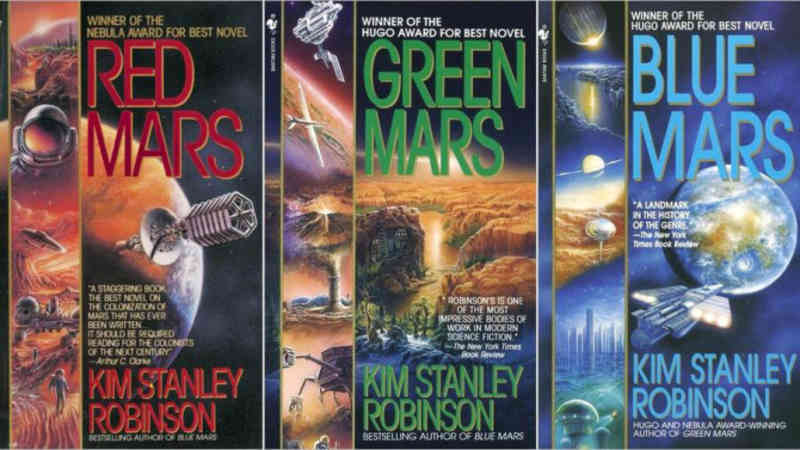
In my opinion, however, the most important hard science fiction novel of our time, and also the most important novel both on Mars and the colonization and terraforming of our neighboring planet, is Kim Stanley Robinson’s Red Mars and the rest of the Mars Trilogy. No amount of argument or praise or criticism or glorification that I present in this review will ever be enough to fully grasp the importance of the novel, but it is my hope as your reviewer that by the end of this article, you will be interested in exploring Red Mars.
If reading books isn’t your cup of tea, then the good news is that Spike TV has bought the rights to produce a 10 episode TV Show about Red Mars with Kim Stanley Robinson as one of the consultants. I will absolutely be reviewing the show when it comes out. I’ve been waiting more than a year for any new updates on it, so hopefully I’ll be able to cover it here in future posts.

Now, I know what you’re thinking. Spike TV? No fucking way. I want to however give them the benefit of the doubt since they thought it was a smart idea to purchase to TV rights to Red Mars in the first place. Time will tell if Spike TV knows what it’s doing.
Robinson’s imagination is wide and the feat he has accomplished is something that deserves a Nobel Prize in Literature (call me crazy and biased), because the things that need to be done both on Mars and on the Martian moons Phobos, coupled with the high level of technical and scientific details and hacks that help the new colonists do what needs to be done to establish that first colony felt very realistic and detailed.
The entire time, we slowly learn of two conflicting themes that form the bread and butter of not only Red Mars and the rest of the trilogy, but of the entire reason why anyone would want to go to Mars in the first place. We see the side of the Greens, or the terraforming advocates, as they wrestle with the Reds, or the environmental purists, the ones who want to study the original Martian ecosystem and not begin any terraformation efforts till much later.
Both themes come to play with great arguments about who has a point, but I personally am somewhere in the middle between the Red and Green debate. A lot of the Red environment needs to be protected, preserved, and studied, such as Olympus Mons, Valles Marineris, Tharsis, and Vastitas Borealis, all very beautiful landmarks that should not be altered or at least protected.

However, at least with the case of Vastitas Borealis, because of its large area and lower elevation, any terraforming endeavours will result in it filling up with water, forming the Martian oceans hundreds of years laters, so it might be difficult to preserve that much land.
One other important theme in the story, which I think, really captivates my biggest love for the book and respect for KSR, is the idea of science as an answer to all the problems that humanity faces. The very concept of the scientist being a better public official than politicians is interesting because of the assumption that they will rely mostly on data and logic and inductive reasoning to make their decisions and better serve the society they represent. It also questions whether pure science truly can save humanity, or if humanity is stopping the complete flow of pure science, mostly because of the conflict humanity faces in trusting itself in using it properly. Science, regardless of how magnificent it can be, could be used for nefarious and evil things, which causes for interesting debates.
A thing that KSR’s portrayal of Mars did for me was actually make me feel like I was there. Now, you might think that one can say this about any book they read, or you might assume that I haven’t read that many books in my life, but then I’d say you’re wrong. I’ve been reading since before I can walk. I can understand any thing faster through reading than if one person can explain it to me face to face. So, when I say that a few books really made me feel like I was part of the setting and environment because of how well the author has portrayed the overall landscape, I’m not messing around.

His descriptive portrayal of Mars is different in every chapter, making you really think of how imaginative it is to find different ways to describe a Red Planet every opportunity that rises. For that, I thank KSR for giving me that ultimate feeling of belonging with the First Hundred, like in the following excerpt.
"The short rugged curved mountain ranges were darker than the surrounding countryside, a rust color broken by black shadows.
But both the light and dark colors were just a shade away from the omnipresent rusty-orangish-red, which was the color of every peak, crater, canyon, dune, and even the curved slice of the dust-filled atmosphere, visible high above the bright curve of the planet. Red Mars! It was transfixing, mesmerizing. Everyone felt it."
Take me there now!
While this review has focused on the themes of Red Mars I want to outline to you what’s going to come up in the following sections in this article. I will be going over many things in the book, while not giving away spoilers of any main events that happened in the book. I will be going over the main characters and their personalities and backgrounds WITHOUT discussing their conflicts and love interests and plots, just so you can have an idea who the main characters are and their original motivation, sort of like an extended book introduction to the characters before we hit play.
I’ll also be examining the character’s training and journey to Mars, without revealing any plot details, until they all land on Mars. Since it’s a book about Mars colonization, anyone who’s a fan of Mars terraforming can safely assume that the characters must have trained on Earth before, took a big spacecraft all the way there, and are mostly planning on doing surveys and studies on the Red Planet. I don’t consider those things spoilers, but more like common sense assumptions. It’s kind of like before reading or watching The Martian, the viewer can safely assume that Matt Damon is stuck on Mars and we need to save him. Furthermore I will also want to talk about any similarities and draw parallels between Red Mars and real life.
Here’s what I won’t be discussing in the following section: the actual terraformation approach that is presented in the book. The reason for that is I think it’s a major spoiler to many who haven’t read the books and want to read them. I will however use those terraformation approaches in a new article about Mars terraformation in the future to draw comparisons to what is feasible or not.
With that, I have created a little outline of this review if anyone wants to easily find certain sections for easier navigations.
Table of Contents
Background of the Novel
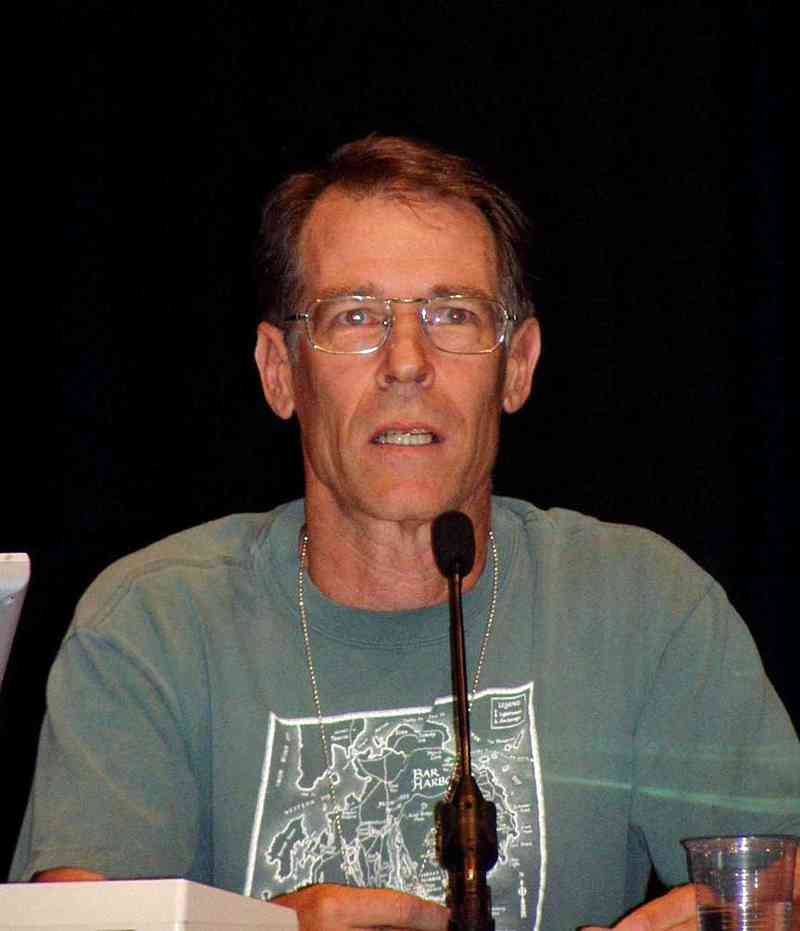
Kim Stanley Robinson, born in 1952, is known for his works on speculative and hard science fiction. Many of his novels have won the Nebula, Locus, and Hugo Awards in the science fiction category. He is considered one of the most important writers of science fiction, and it was recently announced that he won a Robert Heinlein Award in January 2016 for his works on the genre. Before writing the Mars Trilogy and the beginning of Red Mars, he was very passionate about the Red Planet as can be seen is his earlier writings and inspirations. His love for the ecological and environmental can be seen in current works and are featured heavily in the trilogy. It can be definitely argued that The Mars Trilogy are his magnum opus, and his works on advocating for the settlement on the Red Planet should be highly regarded as a benchmark of the standard we need to reach as future colonizers.
His inspiration for writing the Mars trilogy, according to Andrew Liptak’s coverage of the author, is illustrated by KSR’s love of hiking.
"I knew when I saw the photos from the Viking Orbiter, which included stereoscopic 3-D photo pairs where you could see what the landscape might look like, somewhat like early primitive versions of Google Earth. These were NASA publications that came out in the late 1970s."
Robinson's love for hiking the Sierra Nevadas came into play when he began writing science fiction, and he "realized that only by terraforming Mars could you actually backpack there; and there were scientific articles coming out about terraforming Mars in those years, so I paid attention to those, and thought that would be a good story to tell. I spent about ten years thinking about that and collecting research materials."
- Kim Stanley Robinson
Red Mars was published in 1994, a behemoth in both the hard-science fiction genre and the Mars colonization and terraformation genre, winning the Nebula Award for the value of the work. It’s the first part of the Mars Trilogy, which takes place over several centuries, narrating the colonization of Mars to its terraformation to its long term results. The rest of the Mars Trilogy, Green Mars and Blue Mars, take their names from the stages of color of the Red Planet as it undergoes terraforming.
I will only discuss the first part of the trilogy, Red Mars, due to the sheer magnitude of the entire collection. Most KSR fans will tell you only to read Red Mars, and not bother with Green Mars and Blue Mars because of the direction they take. I think it’s up to you, the reader, to decide. I’ve read them all entirely, and while I agree that Red Mars is the best in trilogy, I was very curious about the state of Mars in the following two books and what happened to the characters. I love Green Mars and Blue Mars for entirely different reasons than I loved Red Mars. There’s a certain type of prose and poetry that Kim Stanley Robinson portrays in his continuous beautiful description of the Red Planet, things that should be sacred in the eyes of the many who want colonize the planet. Furthermore, as can be seen by the author’s love of hiking the Sierra Mountains, his passion for the environment and his many descriptions of Mars are downright prophetic.
To be honest, I think Red Mars should be one of the most sacred books for anyone who wants to go help build a Martian colony. I like to think that NASA believes that to be the case as well, otherwise they wouldn’t have included a copy of Red Mars artwork along with the contents of Green Mars aboard the Phoenix Lander as it touched down on Mars in 2008.

That’s fucking crazy, right?
Think of it this way. Of all the works on Mars fiction and love for the Red Planet, NASA decided that Kim Stanley Robinson’s work needs to be the first part of the First Interplanetary Library. That is one hell of an honor, and rightly deserved so. By just reading the first paragraph of Red Mars, we truly understand why.
“Mars was empty before we came. That’s not to say that nothing ever happened. The planet had accreted, melted, roiled, and cooled, leaving a surface scarred by enormous geological features: craters, canyons, volcanoes. But all of that happened in mineral unconsciousness, and unobserved.
There were no witnesses - except for us, looking from the planet next door, and that only in the last moment of its long history. We are all the consciousness that Mars ever had.”
And with that, he sweeps you in with his story as we follow the characters on Mars. One of the many geniuses of Red Mars is the idea of the First Hundred. The First Hundred are a group of scientists and engineers, 70 of them from both Russia and the U.S., while the rest are from other countries, who have been chosen to be the first group of people to be sent to the Red Planet.
If we look at current approaches to Mars colonization plans, none other than NASA and SpaceX have the main idea of sending extremely qualified people first to begin the colonization efforts. Elon Musk’s long term plan would be to send about a million people who would book passage aboard SpaceX for half a million dollar ticket each, but I think that’s an acceptable proposal in the long term as long as SpaceX and NASA first sends the scientists and engineers who will begin the important work there.
I don’t know about any of you, but if I was in charge of a Mars Manned Mission, I wouldn’t want to send first any marketing executive or accountant (not hating on your profession, just saying) as part of the initial colonization efforts, $500K ticket paid for or not. The reason being is that why would NASA or SpaceX spend time teaching them how to do anything useful or technical when they haven’t done anything like that before, much less traveled in a spacecraft?
No, if you are going to send a large group of people, you’re going to start with scientists and engineers and doctors, many of them who know how to do a million other technical, medical, or research duty with ease and confidence while having the passion and will to actually carry out their primary duties. You want to send the best of the best that Earth has to offer. You will be sending the First Hundred.
Now, before going over the cool characters in the novel, I’d like to offer the timeline before the events unfold in Red Mars. The events of the first book begin in the year 2026.
However, in the year 2020, the first Humans arrive on Mars as part of a four person NASA expedition that lands on Chryse Planitia, and the first man to land on Mars is an American that goes by the name of John Boone.
The Characters
John Boone
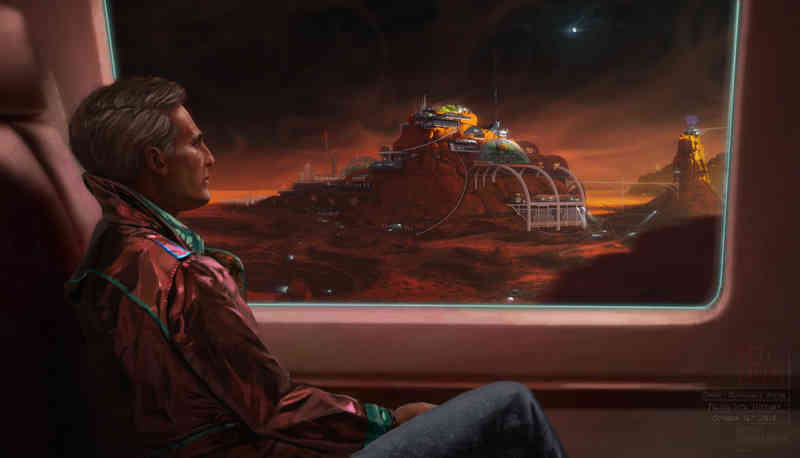
The first Man on Mars.
Let that sink in for a moment. When KSR first wrote Red Mars in 1989, he had to pick someone to be the first Man on Mars, and had to decide on his personalities and traits and features and background and everything else.
When I first heard of John Boone, my mind raced to a portrayal of a futuristic Neil Armstrong (I can’t help it). Since there’s not a lot of artwork out there for The Mars Trilogy, I feel like Travis Smith has captured what John Boone would look like in his amazing fan arts (I’ll be displaying lots of fan arts of the series here in the posts with links to the artists so you can check them out). He’s the guy you can bet will do the right thing, the one with morals and who can probably be manipulated by the more politically savvy.
John Boone, in my opinion, represents the All-American personality of a charismatic leader, with good blonde looks with an undying sense of idealism and optimism, a person that people can look up to and get inspired by, someone people can follow no matter the cause. His charming personality and friendly approach to dealing with everyone quickly makes him the most popular person among the First Hundred. He’s what you get if you took John F. Kennedy and put a spacesuit on him and told him to join an expedition to Mars. He was the first Man on Mars, and for that, we needed someone that NASA had to have handpicked a long time ago to take the first step onto the red planet, an inspiration for everyone around the world.
His first words on Mars were "Well, here we are".
Before the book begins, he has already been to Mars, so the fact that he’s included as part of the American Delegation of the First Hundred while not being their official leader causes irritation to some, including the “official” leader of the American delegation, and his good friend, Frank Chalmers.
Frank Chalmers

There’s a gazillion things I can say about Frank Chalmers (other than him being my favorite character in the story) but the main thing we can begin looking at is his personality and characteristics that made him the official leader of the American Delegation of the First Hundred.
Frank Chalmers in my mind represents a hybrid between a cutthroat American politician and a cunning realist, with the sense of sophistication of a gifted engineer and the improvisation of a chameleon. I love Chalmers’ character a lot more than Boone’s because not only is he one of the smartest people aboard the Ares with his amazing technical skills, command of many languages, and mastery of navigating politics and power plays, but because he is the only person who understands how to make Mars an independent society. Their rivalry is a dynamic yin and yang that keeps readers invested in the series.
I feel that this duo of Boone and Chalmers kinda reminds one person of another historic group of people, the crew of the Apollo Mission.

If you’re confused by who’s who in this picture, then I’m referring to John Boone as Neil Armstrong (pictured on the far left) and Frank Chalmers as Buzz Aldrin (pictured on the far right). I couldn’t find a connection with Michael Collins, so have to skip on him (sorry, Collins).
Chalmers is interesting because you can feel like he was an idealist before, but the years of navigating the political landscape has left him a pessimist about everything, which he carries with him wherever he goes. Still, you can’t help but feel that deep in his heart, he’s one of the very few people on Mars that can establish it as a realistic society. On the opposite side of the American delegation, Frank will have to work with the leader of the Russian delegation, Maya Toitovna.
Maya Toitovna

It is aboard the Ares, the spacecraft carrying the First Hundred to Mars, that we are first introduced to Maya Toitovna, the leader of the Russian expedition.
Maya, oh Maya, where do I begin with you.
In a sense, she’s one of the main souls of Mars, high maintenance and bipolar in her relationship with the other Hundred, yet a brilliant scientist, engineer, and leader. Her emotional connection to Mars isn’t very clear at first, and her responsibilities to her Russian delegation pushes her to be part of love triangle, which generates differing hypothesis about her actions from those really close to her and Duval, the psychiatrist.
While Maya can be a painful person sometimes to read through and understand her motives, I really can’t imagine Red Mars without her. She’s like a “goddess” personality of Mars in a way, beautiful yet harsh.
She shows us the many things the First Hundred have to do when aboard the Ares as it takes them to Mars, with daily constant training simulations to practice for any sorts of danger aboard the Ares, keeping the First Hundred occupied.
Outside the novel, we take a better look at Maya’s upbringing and why she had such an important role in the novels. Not only is she one of the heads of a country delegation and a leader for the Mars mission, but her upbringing included her family instilling in her the importance of women in the cosmonautics field, even if only to provide female data in medical experiments. From a feminist perspective, Maya is very essential in the story because she’s one of many women who have a leadership and highly scientific and technical role, being looked up to by the rest of the population and having drawn lots of admiration and respect by the First Hundred and later settlers. From a political perspective, she reads like a beautiful cobra, who under the many emotional entanglement and displays, she shows a very cunning understanding of power plays and positioning herself in the spotlight at all times, which always makes her an interesting read.
Saxifrage Russells
Sax Russells is one of my favorite characters in the book, who portrays the cliched scientist. He is part of the American delegation of the First Hundred, always an honest and logical creature that eyes everything scientifically.
He is the head of the terraformation efforts on Mars, responsible for many things that help lead the transformation of Mars from the Red Planet as it undergoes many changes. His insights into the terraformation process and the techniques he uses are an interesting read always.
If there was one way to describe his personality, it’s a blend of Sheldon Cooper’s extremely logical and innocent observation of everything around him mixed with Leonard Hofstadter’s mild mannered-ness. He’s the ultimate physicist.

Russells argues that just by being on Mars, humanity is already terraforming it, so the idea that we are resisting terraforming is futile since we are enabling it by being present there.
“The beauty of Mars exists in the Human mind. Without the human presence it is just a concentration of atoms, no different from any other random speck of matter in the universe.
It’s we who understand it, and we who give it meaning. But science is more than that. Science is part of a larger human enterprise, and that enterprise includes going to the stars, adapting to other planets, adapting them to us. Science is creation.
The lack of life here [on Mars] and the lack of any findings in 50 years of SETI indicates that life is rare, and intelligent life even rarer. And yet the whole meaning of the universe, its beauty, is contained in the consciousness of intelligent life.
We are the consciousness of the universe, and our job is to spread that around, to go look at things, to live everywhere we can. It’s too dangerous to keep the consciousness of the universe on only one planet, it could be wiped out…We can transform Mars and build a cathedral, as a monument to humanity and the universe both!”
- Saxifrage Russells, Red Mars
Ann Clayborne
Ann, the Lady in Red of Mars, forms one of the most important ideologies and movements of the Red Planet with her staunch beliefs coupled with her pure scientific reasoning and love.
One of the main characters of the American Delegations, Ann is a geologist whose love of the red planet is so deep and sinister, that she in a way represents the Mars of Old. Her main belief is that Mars needs to be fully studied and surveyed before any terraformation attempts even happen there. Since there are no fan arts or illustrations of Ann Clayborne online, if I had to portray her, I’d pick Dr. Jane Goodall back in her Tanzania days (disclaimer: Jane Goodall is one of my favorite scientists of all time).

Ann is also the portrayal of the cliched scientists, being introverted, bookworm-ish, extremely focused on her work and fighting everything around her for the good of science.
“I mean I look at this land and, and I love it. I want to be out on it traveling over it always, to study it and live on it and learn it. But when I do that, I change it — I destroy what it is, what I love in it.”
- Ann Clayborne, Red Mars
Nadia Chernyshevski
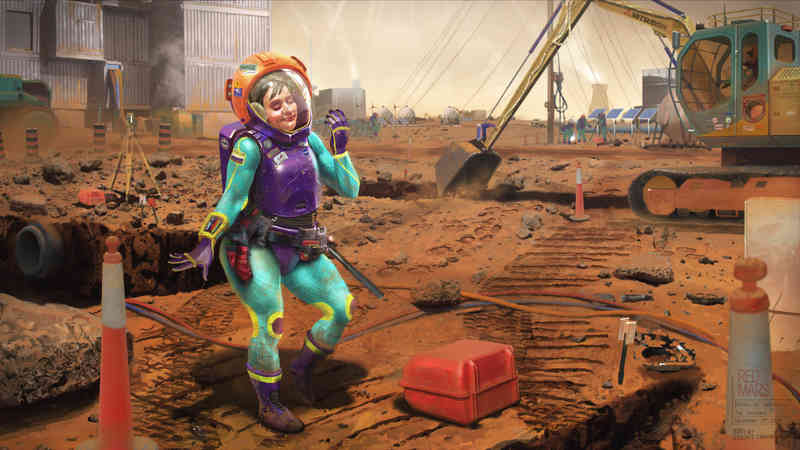
Nadia is an engineer as part of the Russian delegation here on Mars, and although in the beginning of the novel is a background character, she really shines through once the First Hundred reach Mars.
Nadia's characteristics are warm and friendly to everyone around her, immediately making her well liked among the First Hundred. She also heads all the operations of constructing the first settlement on Mars, and it is here that’s the most interesting to see her at work. We are immediately presented with various scenarios and scenes that one can’t seem to imagine until they fall into their lap, and decide how best to navigate or solve them from purely technical point of view.
I’m pretty impressed by the fact that KSR used two female characters on the Russian delegation as not only leaders but also engineers, and I commend him on that decision. STEM needs more women, especially here in North America, and I have always been impressed by the number of women in STEM outside of North America.
Nadia’s role in the Mars Trilogy is a force of building, whether human relationships, settlements, or agreements, always being the positive and optimistic and trying her best to see all sides to every story.
Arkady Bogdanov
We finally reach the most interesting character in the entire story, Arkady. To say that Arkady is quite a character is an understatement. He’s John Lennon, Jim Morrison, Steve Jobs and Elon Musk all wrapped into one sandwich. He’s the biggest rebel there is out there, and yet his motivations and desires are what connect with us the most.
An engineer on the Russian delegation (they do have lots of engineers in Russia, don’t they), Arkady is described as a red haired and bearded comic with many ideas of political establishments. If one had to pick a portrayal of him, I’d go with Seth Green (in terms of appearance, not screen depiction, mind you).

He speaks his mind, not afraid of what others might think, yet still having a mischievous sense of humor that wins over even John Boone. What I think is important about Arkady is his love of anarchy, the type that actually wants a big fat divorce from Earth. It is of importance to note that from early on, he doesn’t want government interference with the new found life he will be setting out to build on Mars, and with that, we grow to appreciate his motives.
“We have been sent here by our governments, and all of our governments are flawed, most of them disastrously. It’s why history is such a bloody mess.
Now we are on our own, and I for one have no intention of repeating all of Earth’s mistakes just because of conventional thinking. We are the first Martian colonists! We are scientists! It is our job to think things new, to make them new!”
- Arkady Bogdanov, Red Mars
Hiroko Ai
Hiroko is the most mysterious yet captivating character in the entire story, mainly because of her philosophies and her approach to building the biosphere. A Japanese world-renowned biosphere designer and the youngest of the First Hundred, Hiroko can be seen having her own following of biosphere designers from the moment they were on the Ares, being somewhat of much talked about legend among the rest of the crew.
It is her that brings an important philosophical concept of areophany, which is believed to be the inhibition of the body of Mars. The philosophy might sound like a religion, but its beauty lies in the fact that it celebrates the growth of living things on Mars, a revival of Mother Nature on the Dead Planet, a nurturing of the environment. Because of that outlook, I would say that Hiroko embodies the entire spirit and themes that the books try to show, a marriage of the Red and Green.

I couldn’t find any fanart of Hiroko Ai (can we please get some artists to generate more fanart? I’ll feature them here) so I had to go with Florence Faivre, the Thai-French actress who recently starred as Julie Mao in The Expanse. If you think it was a pure coincidence that I mention The Expanse, it isn’t, because I’ll be featuring it later on this blog with reviews on Martian themes.
Now, with an overview of those characters out of the way, let’s go to the First Hundred’s training ground.
Antarctica
In Red Mars, we are taken into Antarctica and the long training sessions the First Hundred have to endure to prepare for their journey and survival. This is a smart training package, no doubt helping in understanding how isolation affects the astronauts as they’re cut off from the rest of the world. Consider this, at the Concordia station in Antarctica, the nearest sign of human activity is 600 km away (that's about 373 miles, America), further than the International Space Station, so test subjects are fully cut off.

While in the book, we gently touch upon the First Hundred’s experience in Antarctica, we learn more about each character’s impressions of other colleagues based on their interaction at the Antarctic station. This proves useful for some of the characters as they continue in their work and journey aboard the spacecraft and on their way to Mars.
What is interesting about Antarctica as a training and “filtering” place (I use filtering for lack of a better word, it’s a word my colleagues and I used a lot when working on insane projects to be able to “filter” between the good and mediocre engineers) for the expeditionists. Psychological effects of long term solitude from society is important research that needs to be conducted before any long term mission can go ahead. It also sucks that Antarctica receives no sunlight for 4 months in a row in the winter, and no planes come and go during that time, so it’ll be an ultimate testing ground for humanity. In Antarctica, the First Hundred lived in Wright Valley, familiarizing themselves with all the robotic structures that is already present on Mars, building the habitat that will be awaiting them.
Michel Duval, one of the few non-American/non-Russian characters in the books and the only psychiatrist aboard the mission that is sent to study the other First Hundred, made the following observation about them and how they react to being studied by others.
“So they went on being brilliant and accomplished enough to stand out, but normal enough to get along. They were old enough to have learned a great deal, but young enough to endure the physical rigors of the work. They were driven enough to excel, but relaxed enough to socialize.
And they were crazy enough to want to leave Earth forever, but sane enough to disguise this fundamental madness, in fact defend it as pure rationality, scientific curiosity or something of the sort — which seemed to be the only acceptable reason for wanting to go, and so naturally they claimed to be the most scientifically curious people in history!
But of course there had to be more to it than that. They had to be alienated somehow, alienated and solitary enough not to care about leaving everyone they had known behind forever — and yet still connected and social enough to get along with all their new acquaintances in Wright Valley, with every member of the tiny village that the colony would become. Oh, the double binds were endless!”
- Michel Duval, Red Mars
It’s interesting to note here that of the many applicants that will have to pass the “personality” test in a real life mission, many of them will come to “cheat” it by reacting in ways that will get them favorable reviews with the people conducting the tests. There’s nothing wrong with that at all, because as long as they’re super qualified engineers and scientists and have two other technical specialities that can help in the mission and as long as they get along well with others and are unpressurized, they can disguise a bit of their other personalities from psychiatrists and psychologists. It just makes them humans. For instance, many would be going to Mars because they have been dreaming about it for so long and have been preparing to be selected based on their many technical skills and accomplishments and yet want to strive to build a new community there that will become self-sufficient. They won’t let a stupid personality test -- where if they mess up on one question, it’ll be the deciding factor between being part of the expedition or not -- determine their destiny.
The Ares
Next, we board the Ares, the largest interplanetary spacecraft ever built in the book, where the First Hundred stay for the many months before reaching Mars. Ares is divided into the Russian and the American sections, and the leaders of each delegation interact with one another, agreeing that such a division is unnecessary and offer to exchange rooms with one another, allowing for mingling and getting to know one another.
The spacecraft was built from space shuttle external fuel tanks that have been boosted to orbit instead of detached from flights to the low gravity, where they were used for the construction of Ares. It’s interesting how back in 1989, when KSR first began writing the books, his assumption on a future aircraft for a Mars Mission is one that was made from existing space shuttle technology. Inside the living habitations on the Ares, the team is getting used to a 0.38g psuedogravity that will help prepare them for Martian gravity.
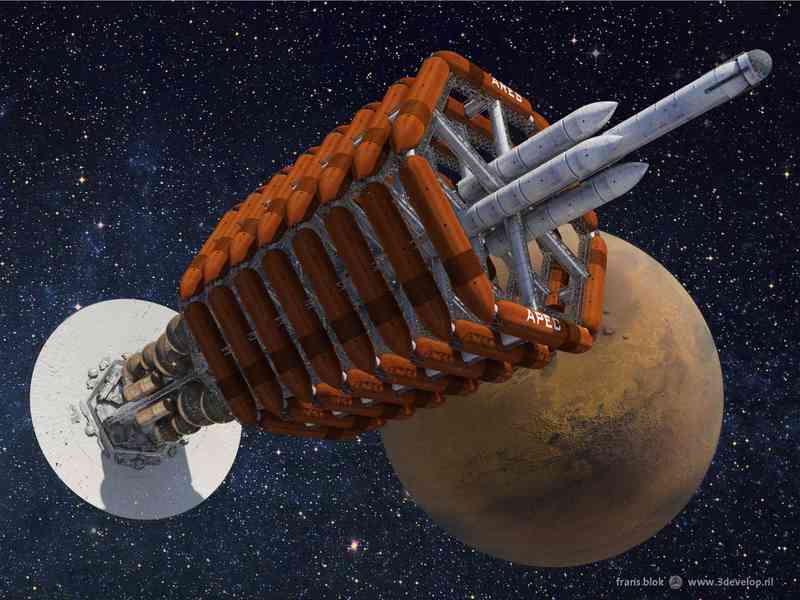
Regarding the Ares and similarities to modern projects, SpaceX has announced that they have plans for something similar, the Mars Colonial Transporter, which will use reusable rockets, space engines and capsules to transport people to Mars and back. Elon Musk has stated he hoped to unveil more details of the mission in September 2016 at the International Astronautical Congress. Apparently some designers took it upon themselves to apply what little information that Elon Musk and co. revealed to show you the following concept of MCS.

It seems like it can fit about a 100 people according to Musk, and that’s as good as any number to start the expedition to Red Mars and begin the terraformation process. On Mars, there’s millions of things to do and that’s where things get really interesting.
Looking Ahead
So far, this review has been covering the many aspects of the travel to Mars through the eyes of Red Mars without having to do deep into details about certain parts of the book such as how the terraformation actually happens, what sort of conflicts arise on Mars, among many other things. In other future posts about terraformation as a topic, I will look more closely to examples used in this book and others like it, but for now, I don’t want to review every aspect and idea in the book since it would potentially spoil the book to many people who haven’t read it. I’ve tried to keep this review spoiler free by not giving away any major plot points that will affect the enjoyment of it to new readers. Chief among them is the terraformation efforts for one main reason being, it is the most important conflict and struggle that will divide many readers as they witness how the different characters feel about the terraformation.
In future articles, I’ll be using many of the character’s arguments in any topic on Mars, as well as using any real people arguments as they are fit. But since we have reached near the end of the review, I hope you guys are interested enough in reading more about Red Mars.
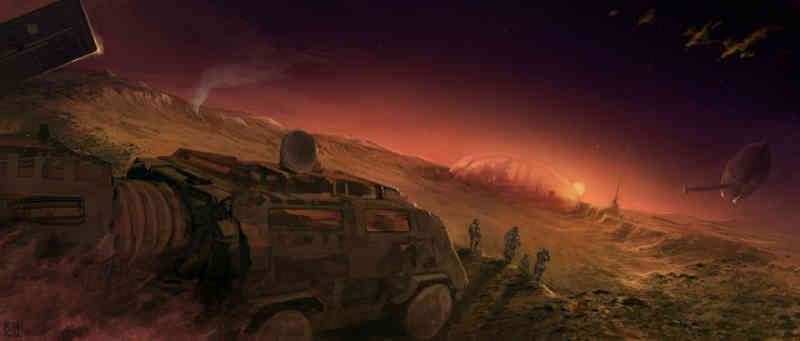
With that, I hope I’ve given you enough reasons to explore this book on your own, and if you’ve already done so before and would like to discuss it in the comments. Tell me what I missed in this review or what you loved most about Red Mars, without trying to put spoilers up for people who haven't read it. With any luck, we will see 1% of the events of the book happening in our lifetime, where you and I both will be building the first settlements over there.
-
Why We Need To Save The Expanse
The Expanse follows the crew of the Rocinante and Captain James Holden as they navigate our local solar system. In this palantir into what our future holds, Mars has become an independent military power just like its namesake while the Asteroid Belt has become colonized by miners.
-
A Blockchain For Mars
If say, Martian miners on Valles Marineris want to mine bitcoin, which has the majority of miners on Earth, the delay in communication due to the speed of light will eventually result in a chain split.
-
Dreams of Marsfornication
Part V of The Martian Sex Journal
From the perspective of the dreamers of Mars, if we can’t even colonize the Red Planet, then this whole experiment is jeopardized. If humans can’t inhabit the cosmos, then we are literally stuck to Earth and its problems and warfare.
-
Of Martians and Terrans
Part IV of The Martian Sex Journal
This is where the irony of living on Mars with the dreams of terraforming it lies in the eyes of this tourist Martian visiting and experiencing Earth for the first time. The Martian’s forefathers left this very planet to settle and colonize Mars and terraform it be like Earth, even though they left Earth because they didn’t want to live there to begin with.
Don't Miss Out on those Occupied Mars articles!
comments powered by Disqus





